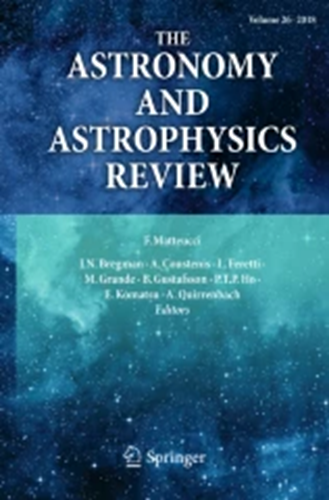Wide companions to M and L subdwarfs with Gaia and the Virtual Observatory
IF 26.5
1区 物理与天体物理
Q1 ASTRONOMY & ASTROPHYSICS
引用次数: 0
Abstract
Aims. The aim of the project is to identify wide common proper motion companions to a sample of spectroscopically confirmed M and L metal-poor dwarfs (also known as subdwarfs) to investigate the impact of metallicity on the binary fraction of low-mass metal-poor binaries and to improve the determination of their metallicity from the higher-mass binary. Methods. We made use of Virtual Observatory tools and large-scale public surveys to look in Gaia for common proper motion companions to a well-defined sample of ultracool subdwarfs with spectral types later than M5 and metallicities below or equal to −0.5 dex. We collected low-resolution optical spectroscopy for our best system, which is a binary composed of one sdM1.5 subdwarf and one sdM5.5 subdwarf located at ∼1 360 au, and for another two likely systems separated by more than 115 000 au. Results. We confirm one wide companion to an M subdwarf, and infer a multiplicity for M subdwarfs (sdMs) of 1.0+2.0 −1.0% for projected physical separations of up to 743 000 au. We also find four M–L systems, three of which are new detections. No colder companion was identified in any of the 219 M and L subdwarfs of the sample, mainly because of limitations on the detection of faint sources with Gaia. We infer a frequency of wide systems for sdM5–9.5 of 0.60+1.17 −0.60% for projected physical separations larger than 1 360 au (up to 142 400 au). This study shows a multiplicity rate of 1.0+2.0 −1.0% in sdMs, and 1.9 +3.7 −1.9% in extreme M subdwarfs (esdMs). We did not find any companion for the ultra M subdwarfs (usdMs) of our sample, establishing an upper limit of 5.3% on binarity for these objects.与盖亚和虚拟天文台的M和L亚矮星广泛伴星
目标该项目的目的是确定光谱确认的M和L贫金属矮星(也称为亚矮星)样本的广泛共同固有运动伴星,以研究金属丰度对低质量贫金属双星的二元分数的影响,并改进从高质量双星中确定其金属丰度的方法。方法。我们利用虚拟天文台工具和大规模的公共调查,在盖亚寻找一个光谱类型晚于M5、金属丰度低于或等于- 0.5指数的明确定义的超冷亚矮星样本的共同运动伴星。我们收集了我们最好的系统的低分辨率光学光谱,这是一个由一个sdM1.5亚矮星和一个sdM5.5亚矮星组成的双星,位于~ 1 360 au,另外两个可能的系统相隔超过115,000 au。结果。我们确认了M亚矮星的一个宽伴星,并推断M亚矮星(sdMs)的多重性为1.0+2.0−1.0%,预计物理距离高达74.3万au。我们还发现了四个M-L系统,其中三个是新发现的。在样本的219个M和L亚矮星中没有发现更冷的伴星,主要是因为盖亚探测微弱光源的限制。我们推断sdM5-9.5的宽系统频率为0.60+1.17−0.60%,预测物理分离大于1 360 au(高达142 400 au)。本研究表明,sdMs的多重率为1.0+2.0−1.0%,极端M亚矮星(esdm)的多重率为1.9 +3.7−1.9%。我们没有发现我们样本中的超M亚矮星(usdMs)的伴星,建立了这些天体的双星率上限为5.3%。
本文章由计算机程序翻译,如有差异,请以英文原文为准。
求助全文
约1分钟内获得全文
求助全文
来源期刊

The Astronomy and Astrophysics Review
地学天文-天文与天体物理
CiteScore
45.00
自引率
0.80%
发文量
7
期刊介绍:
The Astronomy and Astrophysics Review is a journal that covers all areas of astronomy and astrophysics. It includes subjects related to other fields such as laboratory or particle physics, cosmic ray physics, studies in the solar system, astrobiology, instrumentation, and computational and statistical methods with specific astronomical applications. The frequency of review articles depends on the level of activity in different areas. The journal focuses on publishing review articles that are scientifically rigorous and easily comprehensible. These articles serve as a valuable resource for scientists, students, researchers, and lecturers who want to explore new or unfamiliar fields. The journal is abstracted and indexed in various databases including the Astrophysics Data System (ADS), BFI List, CNKI, CNPIEC, Current Contents/Physical, Chemical and Earth Sciences, Dimensions, EBSCO Academic Search, EI Compendex, Japanese Science and Technology, and more.
 求助内容:
求助内容: 应助结果提醒方式:
应助结果提醒方式:


